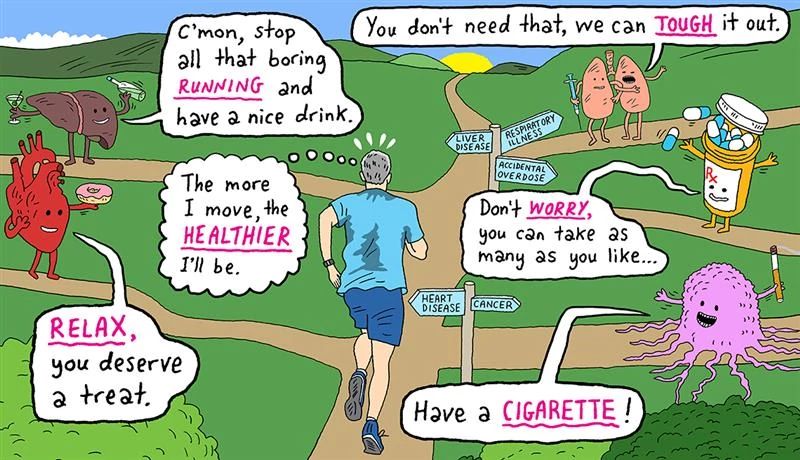AARP Hearing Center


To help you stay on top of your biggest risks, AARP looked at eight of the leading killers of people ages 50 and older, according to the Centers for Disease Control and Prevention (CDC), and quizzed the top scientists in each area for their best advice.
Cancer
Let’s start with the bad news: “By the time you reach 50, you’ve got well over 70 billion cells with cancer-associated mutations in your body,” says James DeGregori, deputy director of the University of Colorado Cancer Center. And that number increases with age.


AARP Membership— $12 for your first year when you sign up for Automatic Renewal
Get instant access to members-only products and hundreds of discounts, a free second membership, and a subscription to AARP the Magazine.
That doesn’t mean you have cancer or you’ll eventually get cancer, he says. Even people who go their entire lives without a cancer diagnosis have these mutations. “Our bodies have evolved amazing mechanisms to stop cancer in its tracks,” DeGregori says. “But all it takes is one of those cells to go rogue, and it becomes full-blown cancer.”
Those odds increase after the age of 50, when “90 percent of cancers occur,” DeGregori says. Your risk more than doubles during this decade, according to the American Cancer Society.
That’s because your immune system has taken a beating over the years, and it’s not as efficient at killing cancerous cells as it was during those first five decades. “The cells in our body are constantly being exposed to DNA damage, whether it’s sunlight or pollutants from our environment,” says Wendy Chen, M.D., an oncologist at the Dana-Farber Cancer Institute. “Our body is always furiously trying to repair it, but after 50, the balance between repair and damage doesn’t always match up.”
Still, there are steps you can take to help your immune system bring its A game.
1. Get the screenings you need.
“If you do nothing else when you’re 50, get screened for cancer,” says Nigel Brockton, vice president of research at the American Institute for Cancer Research (AICR) and a two-time cancer survivor.
Which screenings are right for you? It depends on your lifestyle and family history. To get started, Brockton suggests visiting cancerhealthcheck.org, run by the AICR. “It’s a quick assessment that can alert you to your specific lifestyle risk factors,” he says.
It can also prompt you to have a more meaningful talk with your doctor. “Everyone knows that women should be getting mammograms every two years after 50, and if you haven’t already, it’s time to schedule that colonoscopy,” Chen says. The average age for a breast cancer diagnosis is 62; for colon cancer, it’s 66 for men and 69 for women.
“But what about screenings for lung cancer or cervical cancer or prostate cancer? Not everyone needs them, but you’ve reached an age when it’s time to discuss it with your doctor. It’s up to you to be the squeaky wheel,” Chen says.
2. Get vitamins from plants when possible.
Most studies have found that nutritional supplements aren’t very effective at lowering cancer risk, DeGregori says. “You’re better off getting your vitamins the natural way, with fresh fruits and veggies.”
Plant-based foods contain thousands of unique compounds (polynutrients) that “help repair DNA and potentially slow the growth rate of some cancer cells, among many functions,” says Annette M. Goldberg, a dietitian at the Dana-Farber Cancer Institute. They’re low in calories, making it easier to control or lose weight, which is especially important given the connection between obesity and a higher risk for breast, colorectal, esophageal, kidney, gallbladder, uterine, pancreatic and liver cancers.
Be wary of “super-foods” that promise “a silver bullet,” Goldberg says. There’s no conclusive evidence that any specific food is necessary to prevent cancer. The key is variety, not cherry-picking one magic food that’ll save you.
3. Take a brisk walk.
Regular exercise is one of the most effective ways of reducing your cancer risk, and even short periods of activity can help, Chen says. A 2023 study published in JAMA Oncology found that subjects who walked briskly four to five minutes a day, even if they didn’t otherwise exercise, were 31 percent less likely to die of 13 different types of cancer than people who just strolled gently from place to place. The key is walking quickly rather than leisurely.
4. Worry less.
“In addition to a healthy diet, exercise and not smoking, limiting your stress should be part of your strategy for reducing the risks of cancer and other diseases,” DeGregori says. So be healthy — but don’t stress about being healthy. “You’ll undo any good you’re accomplishing if you’re just worrying about not doing enough.
“Do I still have a beer at night?” DeGregori says. “Sure. I just don’t have three beers.”
Heart disease
The average age for a first heart attack is the mid-60s for men and early 70s for women, but there’s every reason to believe that you — yes, you — are already on the path toward heart issues starting at 50 .
“The average 50-year-old is going to have some thickening and hardening in their coronary arteries, some plaque buildup,” says Seth Martin, M.D., a preventive cardiologist at Johns Hopkins Hospital. Atherosclerosis — the buildup of plaque that puts us at risk for a heart attack — happens rapidly between the ages of 40 and 50, according to a 2020 study in the Journal of the American College of Cardiology.


Since 2011, the death rate from heart disease for those of us ages 45 to 64 has ticked upward by 4 percent, according to the CDC. “More Americans than ever are now overweight, and most of them are middle-aged,” Martin says. People in their 50s are less physically active, consume more sodium and are more likely to smoke and less likely to take cholesterol drugs than those over 65, according to CDC data.
“This is the decade where these problems really start to manifest,” Martin says, “and now is the time when you should be doing something about it.”
1. Know your numbers.
Get your blood pressure and cholesterol and glucose levels checked at least once a year, and make sure to tell your health care provider about any relatives who have had heart disease before age 65. While you’re there, ask about your calcium score.
Wait … what’s that?
“It’s a five-minute CT scan that looks to see if you have any plaque around the arteries of your heart,” says Marc S. Eisenberg, M.D., an associate professor of medicine at Columbia University and coauthor of Am I Dying?! A Complete Guide to Your Symptoms — and What to Do Next.
If you have a moderate risk for cardiovascular disease because of high blood pressure, high cholesterol or family history, your doctor may want you to take just such a scan. A score between 1 and 10 means you have a less-than-10 percent chance of developing heart disease, while a higher score means you should consider more aggressive preventive measures, such as taking cholesterol medication, Eisenberg says.
2. Hit the trail.
Even after a lifetime of inactivity, regular exercise can do wonders for your heart health.
“If you find at least a few minutes every day to walk with just a little urgency, like you’re trying to catch a bus, that’s almost better than anything a doctor could do for you,” Eisenberg says. When you’re ready to get more ambitious, shoot for 40 minutes of walking per day, five days a week. “The effects can be as profound as taking a statin,” he says.
Just like walking for cancer prevention, the pace should be brisk. If you can carry on a conversation but you’re breathing a little harder and your heart rate increases during your walk, it will have the most beneficial effects.
3. Don’t skip breakfast.
“People who skip breakfast may be at higher risk for heart disease,” although further study is needed, says Kershaw Patel, M.D., a preventive cardiologist at Houston Methodist Hospital. A study of 6,550 adults found that skipping breakfast made them 2.5 times more likely to die of a heart-related episode than those who ate breakfast every day. Another study found a 21 percent increased risk for cardiovascular disease among people who waited until midday to eat.
“In general, a healthy breakfast includes fresh foods,” Patel says. If you’re somebody who considers coffee and a pastry “breakfast,” try planning in advance to make sure you get the most heart-healthy options, from grab-and-go hard-boiled eggs to rolled oats, yogurt and fresh fruit.
4. Make time for sex.
Having sex at least twice a week can reduce a man’s chances of dying from heart disease by 50 percent, according to a study in the American Journal of Cardiology, while women who report satisfying sex lives are less likely to develop peripheral artery disease.
But it’s about more than the sex. Simply being alone and isolated can increase your risk of cardiovascular disease by up to 29 percent. For men, in particular, feeling emotionally supported in a happy marriage can lead to better heart health overall.

































































You Might Also Like
AARP Smart Guide to Keeping Your Memory Sharp
22 science-backed ways to growing a healthier, happier brain, now and in the future
Try These Tips for Living a Healthier Life
Small changes can add up to big mental and physical results
AARP Smart Guide to Seasonal Allergies
Achoo! How to understand and treat your symptoms
More Members Only Access
Enjoy special content just for AARP members, including full-length films and books, AARP Smart Guides, celebrity Q&As, quizzes, tutorials and classes
Recommended for You